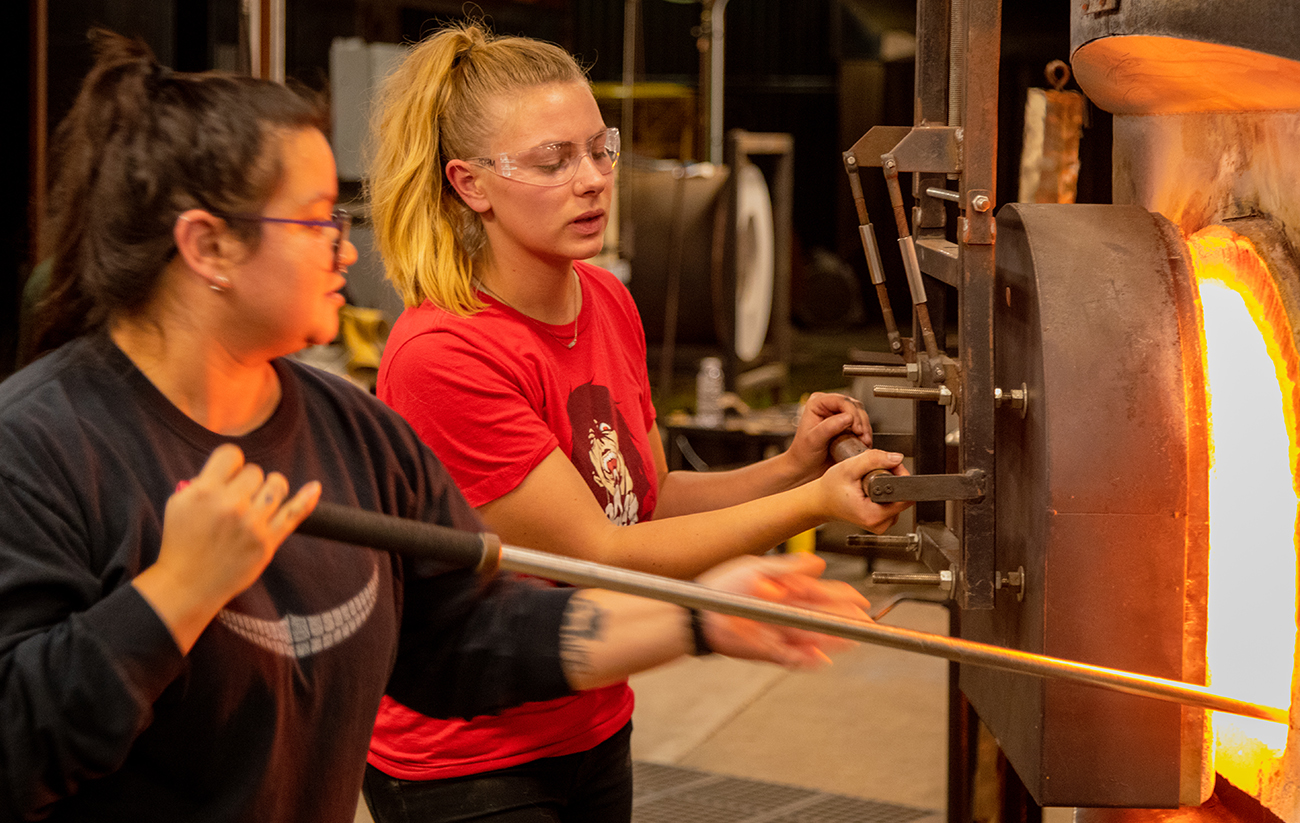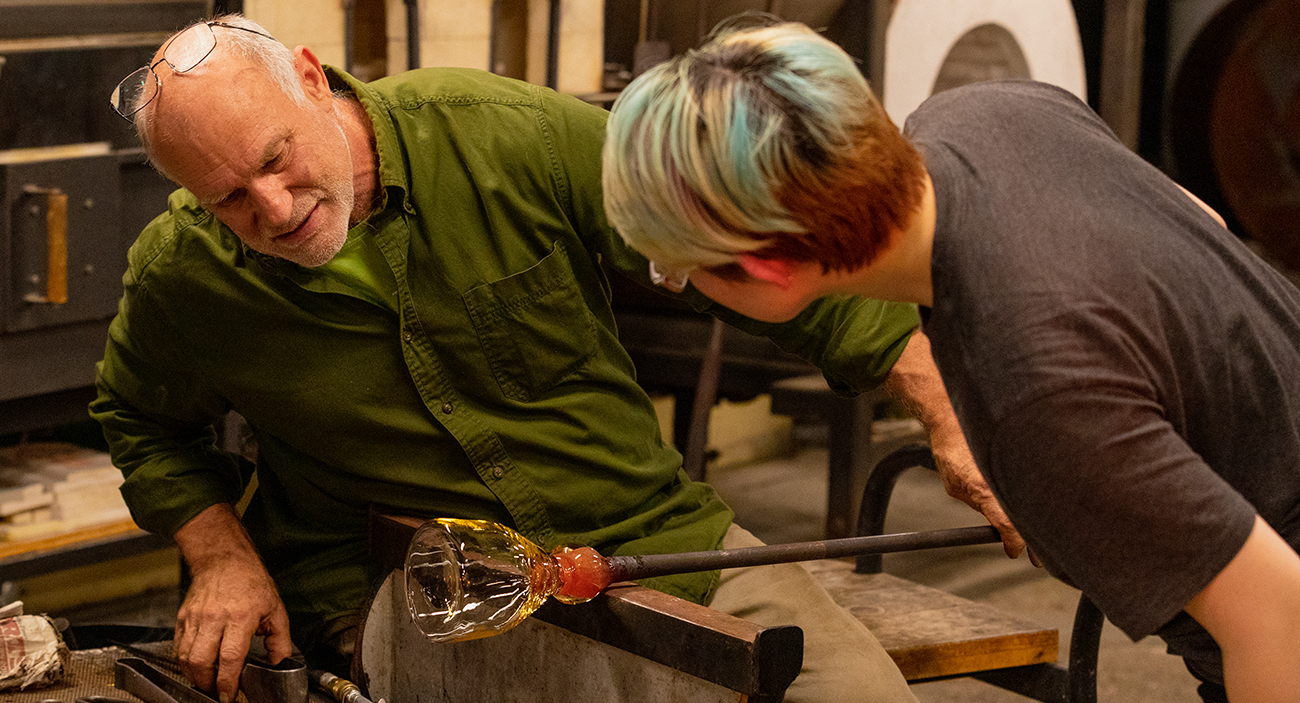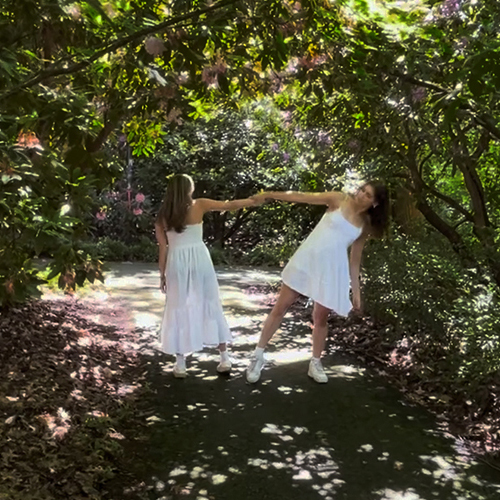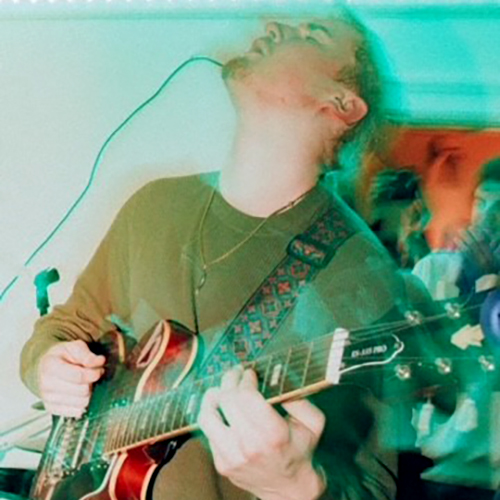
“It’s like being in the middle of a volcano. In molten states, there’s this primeval Promethean quality to it. The way it moves between liquid states and solid states is a beautiful thing.”
Mark Zirpel is talking about glass, a material he finds endlessly fascinating. That makes sense given that Zirpel heads the glass program in the UW School of Art + Art History + Design (SoA+AH+D) — a program he built from the ground up after joining the faculty in 2008 as the Dale Chihuly Endowed Chair of Glass.
It hasn’t been easy.
When Zirpel arrived, the Pacific Northwest was already a hub for glass. Since the 1970s, many glass artists have located in the Northwest thanks to the esteemed Pilchuck Glass School, established by UW alumnus Dale Chihuly (BA, 1965). But the University of Washington had no glass program. A group of philanthropic art collectors recognized the need and created the Chihuly Endowed Chair of Glass to support a faculty position and fund a new building with glass studios, faculty offices, and a gallery.
“A graduate architecture class designed three absolutely spectacular studios and created models,” Zirpel recalls. “And then the economy tanked and things unraveled from there.”

With the recession, the new building was no longer a possibility. The School began offering glass classes at Pratt Fine Arts Center in Seattle’s Central District, and then in the UW’s Ceramic and Metal Arts (CMA) Building. With limited resources but an abundance of determination, Zirpel set out to acquire glass-working equipment on a shoestring budget.
Zirpel had to prioritize since the four main techniques for working with glass require different equipment. Kilnforming, including techniques like fused and molded glass, uses kilns that reach 1500 degrees. Cold glass, usually a finishing technique for other processes, requires specialized saws, drills, and sanders for grinding and polishing. Flameworking involves heating and manipulating glass using an oxy-propane torch. Hot glass or blown glass requires a furnace that can melt glass into molten liquid and kilns that serve as annealers to slowly cool the material.
As soon as you get glass out of the furnace it starts cooling off and becoming harder to work with, so you can’t be tentative.
Ramping up facilities for kilnforming, cold glass, and flameworking took nearly four years and ingenuity, including building several kilns from scratch and negotiating an affordable supply of raw material. Adding a hot glass studio took another four years. Sean O’Neill, instructional technician for the program and an experienced glassblower, was able to secure two electric furnaces donated by Glassybaby, and a bounty of used equipment from a glass studio that was closing. “The furnaces were very well used, so I took them down to the bones and reassembled them into one that would work well,” says O’Neill.

Zirpel identified a covered area outside the CMA Building that could function as an area for hot glass, but there was still the matter of bringing electricity to the site. Hot glass requires enough power to run a furnace at sustained temperatures of 2000 degrees or more, while also powering pick-up ovens, kilns and other equipment. “To run electricity to the site was really costly,” says Zirpel. “It would have taken years of my budget just to get the power there.” To help the program over this final hurdle, College of Arts & Sciences Dean Robert Stacey dedicated College funds for the electrical work.
With the glass program fully operational, students now have enviable opportunities to explore. But first they must overcome fears about working with furnaces and molten material. “People’s instinct is to want to stay away from the heat, which is the opposite of what needs to happen,” says O’Neill. “You have to get them to move forward into a zone of discomfort so they can be more efficient. As soon as you get glass out of the furnace it starts cooling off and becoming harder to work with, so you can’t be tentative.”

Some students, like junior Candise Salinas, are drawn to the medium. Salinas came to the UW with glassblowing experience and has relished opportunities to explore all the glass program offerings. (Her favorites are kilnforming and flameworking.) “I’m excited to have access to so many tools and the space to use them,” says Salinas. “I’ve never found any other place that has all the resources, people, and great connections to the local glass community that I have here at the University of Washington.”
Thanks to those connections, Zirpel has invited guest artists — as many as four during an academic quarter — to contribute in a variety of ways. Some teach a class session, others share their work and artistic process. “Sometimes we just turn them loose in the hot shop to work alongside our students for a couple of days,” says Zirpel. “We want to show students what an artist working in glass looks like.”
With support from the Chihuly Endowment, Zirpel also hires visiting artists to teach for a quarter. This year he plans to have a glassblower and possibly a flameworker teach courses. “There are literally dozens if not hundreds of qualified artists to tap into around here,” he says.
Some of those artists are alumni who first discovered glass as UW students. But even those who pursue unrelated careers are changed by working with glass.
“We strongly encourage the pursuit of research and curiosity,” says Zirpel. “We want students to have exposure to glass as a fascinating material, with opportunities for experimentation and failure. Hopefully the experience will stay with them when they leave here and be something they always carry with them.”
. . .
To learn how you can support the glass program, contact Merith Bennett at mab4@uw.edu or contribute online to the Dale Chihuly Endowed Chair of Glass.
More Stories

Dancing Across Campus
For the dance course "Activating Space," students danced in public spaces across the University of Washington's Seattle campus this spring.

Celebrating Contemporary Indigenous Music
Markus Teuton, a musician and citizen of Cherokee Nation, explores contemporary Indigenous music through his academic work and as host of “Indigenous Jazz,” a radio show.

All the World's a Stage — and a Game
Students in DRAMA 480 learn how techniques used in game design can be adapted for interactive theater productions.